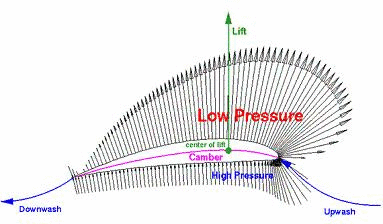Fixed-wing aircrafts generate
lift by passing air at different speeds above and below the wings. The difference in the wind speed creates the
lift, which keeps the wing (and the plane) afloat:). The greater this difference, the more is the lift, which is proportional to the speed of the aircraft; lower the speed, smaller is the lift. Many a small aircrafts stall (lose the lift) when they are moving at slower than recommended speeds or are making sharp turns which reduces the speed.
It
seems that when the wings of such airplanes are vibrated using sound-emitting plastic coatings, they stay afloat even at slow speeds! The sound helps control the flow of air over the wings, reducing the chance of the aircraft stalling:):).

Aerofoil (Courtesy: North Sail Sod)The research was conducted by
Ian Salmon, an engineer with
Qantas Airways in Sydney, while he was at the
University of New South Wales. Tests using a barely audible sinusoidal tone of about 400 Hz (vibrations per second) showed a 22% increase in lift, compared with a standard wing. This could translate into a few extra seconds of time for a pilot to boost a plane’s speed before it stalls!
The technique could have other advantages. The size of a small plane’s wings is determined by the need to avoid stalls during take-off and landing. So if you use this device to improve lift at low speed, you can potentially decrease wing size, thereby reducing the plane’s weight and its fuel requirements:):).